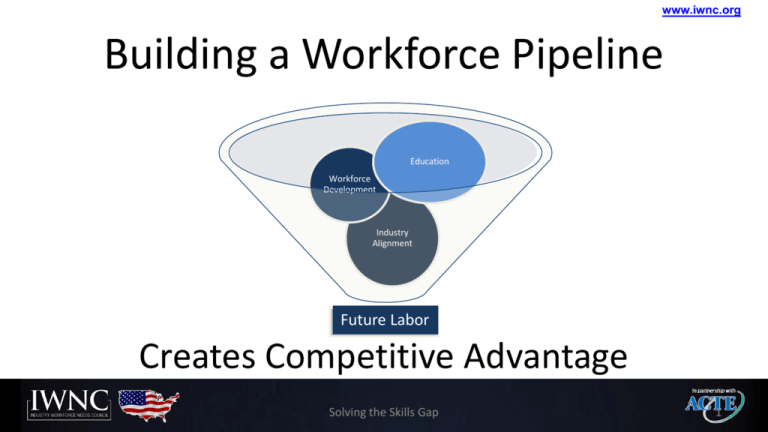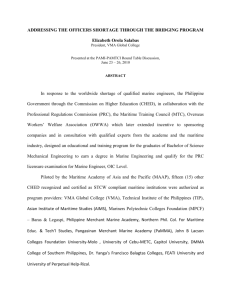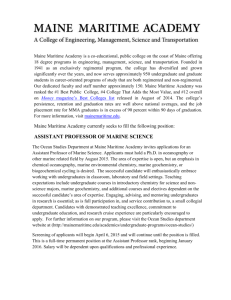USDOL Plenary Session - Industry Workforce Needs Coalition
advertisement

www.iwnc.org Building a Workforce Pipeline Education Workforce Development Industry Alignment Future Labor Creates Competitive Advantage Solving the Skills Gap 1 www.iwnc.org WHY THE DISCONNECT BETWEEN Education Workplace Solving the Skills Gap 2 www.iwnc.org Education Challenges Less time for CTE Disconnect – ed / work Common Core Teacher shortages Academic achievement focus College for all Education Solving the Skills Gap Rigid Funding 3 www.iwnc.org Industry Challenges Fast pace environment Quick / agile processes Changing equipment & rapid adoptions of new tech. Jobs go where skills are Globalization / Global competition Industry Solving the Skills Gap Changing skills 4 www.iwnc.org The Changing Workplace • By 2018 • need 22 million new college degrees • fall short by at least 3 million associate or better • need at least 4.7 million new workers with postsecondary certificates • 90% of the fastest-growing jobs will require an education beyond HS • 31% of small business owners can’t fill positions • 41% of manufacturers Solving the Skills Gap 5 www.iwnc.org Middle Skill Workers Changing • • • • • 29 million middle jobs pay $35,000 or more 11 million+ middle jobs pay $50,000 or more 4 million+ pay $75,000 or more 40%+ require education beyond HS / less than a Bachelor’s degree New and enhanced skill requirements / increased reliance on tech Solving the Skills Gap Source: Association of Career & Technical Education 6 www.iwnc.org New Workplace Norm Increased productivity brought about by technology Workplace will require advanced technical skills-work with advanced computer systems Workplace Availability of skilled workers drives decisions on business locations Collaboration between business, education, community groups, and policy impact decisions Solving the Skills Gap 7 www.iwnc.org Future Career Paths Careers will more resemble a lattice, rather than a ladder More lateral moves on the way up Solving the Skills Gap Multiple jobs stitched together to form a more flexible work environment 8 www.iwnc.org Society Challenges 2010 to 2025 Up to 78 million Baby Boomers leave the U.S. workforce or change work focus Only 40 million Gen X’ers and Y’ers will be available to replace them Solving the Skills Gap 9 www.iwnc.org Today’s Youth are Different 93% U.S. teens 12-17 used Internet in 2009 73% of teens use social networking websites in 2009 64% created content on Internet 62% get news on events/politics online Access information via the Internet Students electronically engaged but face to face is used less often The fastest growing segment of computerusers today in the U.S. is 5 to 7 year olds Communicate via • Social networking sites • Texts • Pinterest Solving the Skills Gap 10 www.iwnc.org What industry needs Workers with Lifelong learning Multicultural Systems thinking / problem solving Ability to express one’s self Critical thinking Solving the Skills Gap 11 www.iwnc.org Why should industry be involved? Increase pool of qualified applicants Lower training costs Reduce cost of selection Lower employee turnover Increase positive public relations/ provide greater exposure in the marketplace Solving the Skills Gap 12 www.iwnc.org Ways to engage; pull out handout Serve on Advisory Board Subject Matter Expert Engage with Youth Mentor students in a career Provide job shadowing opportunities Curriculum Review Increase knowledge via externships Provide students opportunities to visit work sites Support Career Technical Student Organizations (DECA, FBLA, FFA, Skills USA) Present industry information in training or presentations ID of equipment needs Provide tech. and equip. that your workforce uses Solving the Skills Gap School based enterprise Apprenticeship 13 www.iwnc.org Business Open Houses and Tours EXAMPLE: • F.O.C.U.S “Fostering Our Communities’ Understanding of STEM” • Chamber of Commerce • STEM opportunities • Activities hosted by companies – for students, teachers, parents • Sign up through flyer Solving the Skills Gap 14 www.iwnc.org Business open houses and tours • Two purposes: – Inform parents about the business – Foster student engagement • Important that they are: – Connected to State curriculum – Students “do something” not just tour Solving the Skills Gap 15 www.iwnc.org Industry / Education Partnership Transparency Value Solving the Skills Gap Collaboration 16 www.iwnc.org Collaborative Effort • Funded by the Helios Foundation • Hillsborough Education Foundation is the fiscal agent • Career and Technical Education administers the grant to develop the programs • Funding provides PD, Curriculum Development, and Marketing Solving the Skills Gap 17 www.iwnc.org Local Impact of Maritime Industry • • • • • • • Florida’s largest port by tonnage Services 8 million people within 100 miles Economic impact of $8 billion and 100 thousand jobs Major cruise home port Petroleum and energy gateway Expanding container gateway Top shipbuilding and repair center Solving the Skills Gap 18 www.iwnc.org History of Partnership • 2006 Maritime Industry approaches HCPS to with an idea • 2008 Middle School pilot units are introduced in Technology Education classes across the district • 2009 Industry partners and HCPS CTE focus on the development of a complete program (6-12 grade) • 2011 Blake High School opens with one class of 9th grade students in the Maritime Academy • 2013 Magnet High School and two new middle school programs open Solving the Skills Gap 19 www.iwnc.org Development of Curriculum Contributors to the curriculum products: • Dave Sessums, VP, International Ship Repair • Neil McManus, VP, United Ocean Services • Chris Koehler, Attorney, HaydenMilliken, P.A. • Greg Quintana, Representative, MEBA (AFL-CIO) • Paul Duffy, President, Padgett/Swann Machinery • Arthur Whiting, Captain, Harden Marine Associates • Jakub Prokop: DRT, HCPS Solving the Skills Gap 20 www.iwnc.org What does the Curriculum look like? • • • • • • • • • History Careers Ships Engineering Navigation Trade Cargo Security Port Operations • • • • • • • Shipping Operations Mariner Studies Admiralty Law Environmental Marine Resources Oceanography Marine Biology All major areas of the entire Maritime Industry are covered! www.iwnc.org Programs of Study • Meets graduation requirements • Designed to move students into AP courses in preparation for postsecondary enrollment at the National Maritime Academies • Includes advanced coursework such as Macroeconomics, Statistics, and Foreign Language • Students are cohort scheduled with course content “flavored” with the Maritime theme www.iwnc.org Post Secondary Focus • National Universities: – United States Merchant Marine Academy – California Maritime Academy – Great Lakes Maritime Academy – Maine Maritime Academy – Massachusetts Maritime Academy – State University of New York Maritime College – Texas Maritime Academy www.iwnc.org Potential Degrees and Relevant Wage Sample Degrees Median Wage (onset) Marine Engineering $84,850 Maritime Administration Varies Marine Biology $59,330 Power Engineering $79, 230 Marine Fisheries $64,660 Logistics and Transportation $80,860 Marine Sciences $57,420 Marine Engineering Tech* $58,670 Marine Systems Engineering $84, 850 Ocean and Costal Resources $79,050 Marine Transportation $80, 860 Juris Doctorate* $113,310 * Bright Outlook 24 www.iwnc.org Other Careers and Relevant Wage Sample Degrees Median Wage (onset) Ship Captains $63,920 Longshoremen $39,860 Welders $35,920 Sailors ^ $36,800 Freight Agents^* $38,210 Heavy Equipment Techs* $45,600 Freight Inspectors $62,230 Logisticians $71,910 Supervisor of Mechanics* $34,040 ^ Faster than average growth * Bright Outlook 25 www.iwnc.org Support for Teen Work • Many adolescents work, but few of their experiences are connected to their career goals as is now required in CTE work-based programs. • Benefits to students may be realized if classroom-based learning and paid work are connected. (Zimmer-Gembeck & Mortimer, 2006) • Classroom focus on employability skills alone did not result in greater job placement. Structured work experiences that coincided with employer involvement in content design were associated with abilities to find jobs (Cranmer, 2006) Solving the Skills Gap 26 www.iwnc.org Ideal Work-Based programs Curriculum w/Industry Occupational Area School-Worksite Support & Coordination Connecting Activities Mentoring Reflection www.iwnc.org Wisconsin Work-Based Learning Academic & Technical Skills 21st Century Skills WorkBased Learning Solving the Skills Gap 28 www.iwnc.org Work-Based Learning Programs • • • • • Job Shadowing Volunteer/Service Learning Student “work-like” activities Intern/Trainee Work-Based Learning – – – – Co-op, Skills Co-op, YA School-Based Entrepreneurship SAEs Solving the Skills Gap 29 www.iwnc.org Wisconsin Youth Apprenticeship • • • • • • • • • • Program Highlights: 1 or 2 years, 16-17 (Junior &/or Senior year) High school credit Paid on-the job training & experience Employer Mentors Skills vetted by industry aligned to industry standards Skills Standards Checklist YA Coordinators Curriculum Standards- Learning Objectives, Performance Standards Related Instruction Solving the Skills Gap 30 www.iwnc.org Child Labor Laws Child Labor Law Guide Sections • Introduction • Definitions • Work Permits • Liability & Insurance • Hours & Wages • Employment & Equipment Restrictions (Alphabetical) Solving the Skills Gap 31 www.iwnc.org High School Class vs. Employment • School CTE classes vs. employment • Child labor laws only regulate employment, NOT classroom instruction • School has burden to provide safety instruction • Use common sense- RISK ASSESSMENT Solving the Skills Gap 32 www.iwnc.org Student Learner • Must be attending an accredited school (DPI) • Employed on a part-time basis to obtain school credit and employment training • Must have a written school-work training agreement between student, employer and school Must be PAID at least Minimum Wage! Solving the Skills Gap 33 www.iwnc.org Note About Liability & Insurance • Student Learner vs. After School Job • Product, Personal, Worker’s Compensation • Call other WBL Employers! Don’t Know Unless the Employer Asks! Solving the Skills Gap 34 www.iwnc.org Youth Apprenticeships Solving the Skills Gap 35 www.iwnc.org Externships • STEMersion videos Solving the Skills Gap 36 www.iwnc.org Benefits to Businesses • • • • Increase employee recruiting opportunities Lower training costs Lower employee turnover Increase positive public relations/ provide greater exposure in the marketplace Solving the Skills Gap 37 www.iwnc.org Ways to engage; pull out handout Serve on Advisory Board Subject Matter Expert Engage with Youth Mentor students in a career Provide job shadowing opportunities Curriculum Review Increase knowledge via externships Provide students opportunities to visit work sites Support Career Technical Student Organizations (DECA, FBLA, FFA, Skills USA) Present industry information in training or presentations ID of equipment needs Provide tech. and equip. that your workforce uses Solving the Skills Gap School based enterprise Apprenticeship 38 www.iwnc.org How to get started • Contact your local – High School Principal – Career Technology Educator – Community College • IWNC for additional information Solving the Skills Gap 39 www.iwnc.org Questions? Solving the Skills Gap 40






